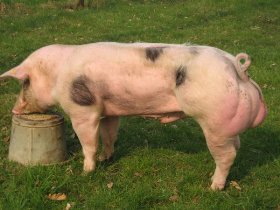Genotype pig study reveals growth rates

A genotype research project has been carried out to determine which sire will provide what is needed for pig producers.
Research carried out at the University of Leeds farm conducted with 425 litters (145 Large White type, 140 Hampshire type crosses and 140 Pietrain type crosses) revealed that piglets from Hampshire type crosses grew more rapidly and reached slaughter weight up to seven days before the two other genotypes.
The pigs were more robust and produced what was described by a University of Bristol tasting assessment panel as “good and tender meat”. Pietrain type crosses also exhibited higher feed intake and were more robust than Large Whites type in the trials. They also had a higher lean meat yield.
However, Professor Helen Miller, who led the team of researchers comparing genotypes and their nutritional requirements, pointed out that the Large Whites type (which were used as a control group) did display some positive attributes.
They had good carcase composition, particularly for conventional payment methods, and a good feed conversion ratio (FCR). They also produced what was described by the Bristol tasting panel as “good meat”. The Pietrain type also displayed good carcase composition, along with the highest lean meat yield, especially prime cuts, of all three types.
“We looked at all aspects of production, from litter size and pre-weaning to post-weaning, grower and finisher stages right through to the abattoir to get a break-down of the carcase details,” said Prof Miller. ”We also sent meat samples (20 loins from each genotype x gender group from the weaner trial) to the University of Bristol for assessment of meat quality.”
She explained that Large White x Landrace sows were bred by artificial insemination with Hampshire, Pietrain or Large White semen to generate three different commercial crossbred lines for the trials, which started in 2006.
The piglets were all produced under the same management system, weaning at four weeks and reared to 100kg slaughter weight. They were all slaughtered at the George Adams plant at Spalding where carcase data from the Autofom showed that Hampshire type cross pigs were on average six days faster to slaughter than the Large White type and seven days faster than the Pietrain type.
However, at similar slaughter weight, the Hampshire type yielded lighter carcases than the other breeds with the Pietrain type pigs yielding the heaviest carcase and a greater percentage of lean meat than the other two.
The researchers found that the different genotypes were characterised by the following features
Hampshire type
Rapid growth
High feed intake
Reduced days to slaughter, particularly suitable for attaining higher slaughter weights
Robust
Good and tender meat
Moderate carcase composition – meat yield underestimated by current carcase assessment
Large White type
Moderate growth
Low feed intake
Less robust – may reflect reduced heterosis due to back cross to maternal line
Good carcase composition – particularly for conventional payment method
Good meat
Good FCR on daily basis
©
Pietrain type
Moderate growth
High feed intake
Robust
Good carcase composition
High lean meat yield, especially prime cuts© – particularly suitable for outlets interested in better yield of using the autofom
Good meat
Carcase not adequately assessed by current conventional payment system
In terms of lysine requirement this series of experiments did not identify a need to feed different feeds to different cross breeds. Therefore, existing feeds were suitable for all the crossbreds considered here.
Asked why she felt this study was so important, Prof Miller said: “After all the problems the pig industry has experienced with the PCV2 infection and productivity problems, it was widely believed that different terminal sires might help improve profitability.
“This study provides an impartial assessment of how the different terminal sire breeds perform and it allows producers to base their terminal sire choices on facts obtained using proper controls.”
The three breed types chosen were those most commonly in use in the UK at the start of the trial. The report, Defining the Benefits of New Genotypes, can be downloaded from the BPEX website.











